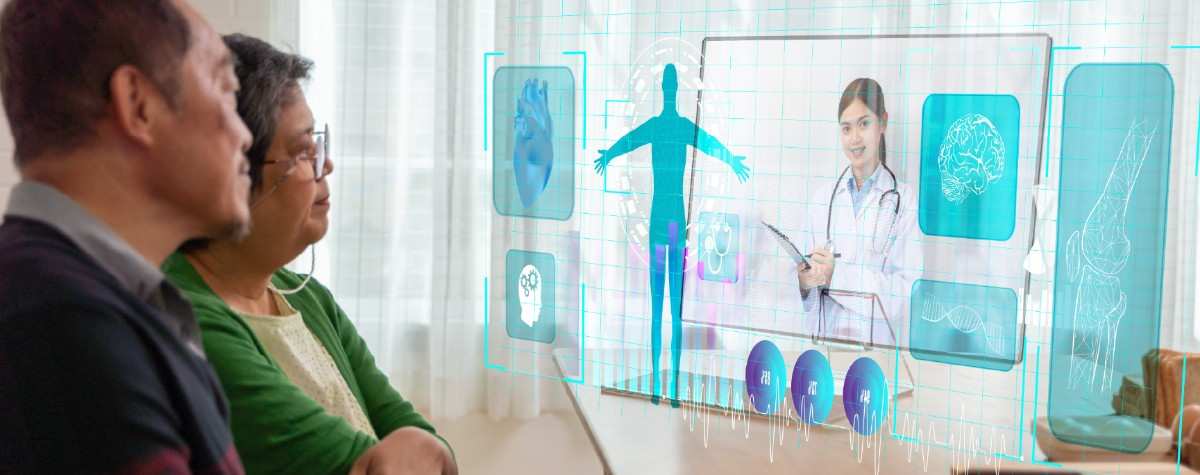


Learn about seamless Epic integration and telehealth, improving patient engagement, data security & efficiency in healthcare.
Epic integration has transformed healthcare delivery, especially in the era of remote care. The healthcare system prior to COVID-19 relied heavily on in-person visits, which both patients and providers preferred over remote interactions. Telehealth was around before, but people usually viewed it as a backup option because it didn’t feel personal. Then, in 2020, the global health crisis turned the healthcare sector upside down, making remote healthcare & Epic integration not just an optional convenience but a necessity.
According to market research, the global telehealth market is projected to reach approximately $121.10 billion in 2025. Telehealth solutions have been adopted by 78.6% of U.S. hospitals in their care delivery models as of 2024, & this trend shows signs of continuing. Telehealth solutions have gained acceptance because their convenience, accessibility, and efficiency have turned what was once an outcast into a transformative force in healthcare. Now, let’s explore Epic integration’s advantages to telehealth platforms and more.
Through digital tools and platforms, telehealth delivers healthcare services from a distance, eliminating geographic limitations and transforming the way patients and providers communicate. Telehealth differs from traditional face-to-face healthcare because it utilizes video consultations alongside remote patient monitoring equipment and secure messaging systems to diagnose and manage medical conditions regardless of patient location.
Through Epic integration, telehealth providers can access telehealth platforms directly from Epic’s EHR system to initiate virtual visits using modules such as Hyperdrive, MyChart, or Haiku/Canto. The integration uses APIs and FHIR (Fast Healthcare Interoperability Resources) standards to enable efficient data transfer alongside secure video connections & improved workflow management. Clinicians use the Epic environment to access patient histories and perform virtual visits while updating notes, creating an integrated experience. Through their HIPAA-compliant video call backends and user-friendly interfaces, Pexip and Caregility empower integration solutions.
Epic Telehealth integration benefits healthcare systems by enhancing care delivery through significant advancements while ensuring clinical excellence remains stable. This effective integration creates substantial advantages for both healthcare organizations & their patients.
Healthcare services have become accessible to patients everywhere, and this development primarily helps people living in rural or underserved regions who had difficulty reaching healthcare specialists before. The MyChart patient portal allows patients to schedule virtual appointments and access & attend them without needing separate applications or additional accounts.
Epic’s telehealth platform features a user-friendly interface that enables patients of any age to navigate scheduling & visit procedures from phones, tablets, or computers. When healthcare providers use automated appointment reminders, they experience lower rates of missed appointments, & patients show better compliance with their treatment regimens.
The use of FDA-approved wearables and smart medical devices provides continuous patient health monitoring regardless of location. The automatic transmission of data from blood pressure cuffs, glucometers, pulse oximeters, and digital scales to medical records helps patients manage chronic conditions, including heart failure, diabetes, and hypertension.
End-to-end encryption maintains patient confidentiality and provides secure privacy protection throughout each consultation to support convenient medical care. GDPR—and HIPAA-compliant video platforms like Doxy ensure the safety of sensitive health information throughout virtual communications.
Integration of Epic technology enables providers to connect with patients more quickly, allowing clinical teams to redirect their time from technology to patient interaction. One unified system handles documentation and lab ordering while reviewing patient history, eliminating redundant tasks & cutting down on administrative workload.
Epic Telehealth enables efficient communication across radiology, cardiology, and emergency medicine teams, making patient care delivery more direct. Organizations integrating departmental expertise can enhance diagnostic quality while speeding up treatment processes.
Through Epic’s Telehealth services, physicians can manage scheduling between organizations to treat more patients and enhance their appointment efficiency. Virtual visits reduce missed appointments & strengthen treatment adherence, which tackles a significant issue in healthcare delivery.
The Epic telehealth enables general practices to reduce costs in areas such as front desk support, material usage, and organizational implementation processes. Through virtual visits, healthcare systems can accommodate more patients without expanding physical infrastructure, resulting in substantial operational cost reductions.
